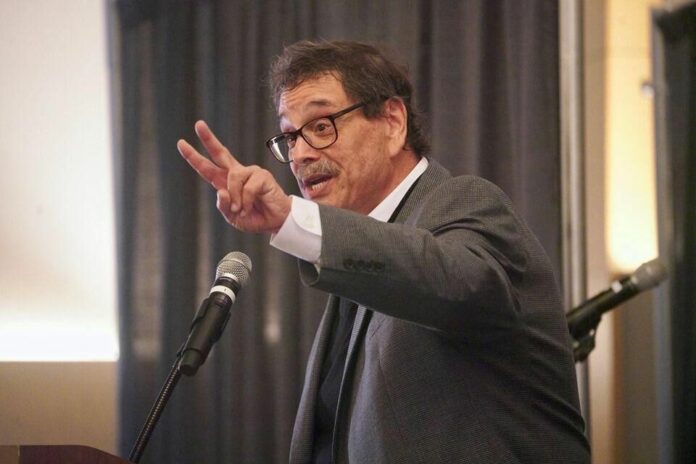
As years of fires, floods and now a pandemic continue to impact Sonoma County residents, members of the Latino community are being hit at disparate rates, making proportionally less money and seeing lower rates of homeownership.
Sonoma County Los Cien hosted its 7th annual State of the Latino Community address, titled “Re-imagining Sonoma County Post-Pandemic,” last week. One of the address’ two panels discussed a shortage of housing in the state and in the county, and ways increased housing development can be supported.
“Most everyone acknowledges that California has had decades of housing long crises, generally impacting the socioeconomically disadvantaged but striking with brute force against the Latino community,” said Los Cien co-chair Oscar Pardo, who moderated a panel on housing during the address. “The underlying systemic factors are generally quantified by red-lining housing practices which oftentimes exclude Latinos and other minority communities from qualifying for mortgages, depressed wages that tend to cause displacement, inflated home prices which tend to make homeownership unattainable and reduced housing stock. All of these factors have been operating in California for decades, but in Sonoma County … we have another set of issues that sit on top of all of this.”
Unique to Sonoma County’s housing struggle is a set of factors and events that have exacerbated issues already present in the state — the Tubbs, Nuns and Pocket fires of 2017, the 2018 west county flood, the 2019 Kincade Fire and now, in 2020, the Walbridge Fire and Glass/Shady Fire (which began after Los Cien’s address) have eliminated housing and displaced people throughout the county.
According to data from the Sonoma County Latino Scorecard, the median household income for Latinos in the county is $59,000 whereas the median household income for white people in the county is $76,000. The county as a whole has a median household income of $72,000. The disparity between Latino and white residents grows when looking at homeownership rates — 38% of Latinos in Sonoma County own homes, whereas 65% of white people own homes. The overall homeownership rate in the county is 60%.
Jennifer LeSar, president of LeSar Development Associates, a firm that specializes in housing policy, resilient community building and homelessness solutions, outlined ways that Sonoma County could help level the field to promote equal homeownership opportunities. Her suggestions include unlocking public land and targeting its development for housing, promoting greater development density and building more condos and townhomes that could lead to less expensive paths to ownership, as well as developing financial strategies that help “equalize levels of homeownership.”
When addressing the impact of the COVID-19 pandemic specifically, LeSar emphasized the need to support and protect tenants and small landlords who may be more vulnerable due to the economic impact of the COVID-19 pandemic.
As of Sept. 29, Latinos make up 54% of the virus cases in the county, and only make up 25.6% of the county’s overall population. Of the county’s virus cases, 24% of positive cases have occurred in people whose race or ethnicity is reported as “unknown.”
“We’ve had fires, we’ve had COVID. Our low-income families are very vulnerable and it’s important that we keep them housed and out of homelessness. At the same time, when they’re unable to pay their rent we put our small landlords also at risk and we shouldn’t be pitting tenants and landlords against each other,” LeSar said, noting that it’s important to think about how local governments or nonprofits can help support Latino tenants.
Referring to housing in the state and in the Bay Area specifically, Jennifer Hernandez, an attorney for Holland & Knight who practices land use and environmental law, talked about how repeated actions in California have led to poor housing opportunities and an environment that’s pricing out longtime residents and minority groups.
“There’s terrific work going on now at UC Berkeley about where and how California is re-segregating by race,” Hernandez said, talking about people who are leaving specific areas in the Bay Area because they can’t afford homes. “We’re spinning out and truly ejecting from oftentimes historically ethnic neighborhoods, minority communities, because of high housing costs. We’ve got high poverty rates because of high housing costs, and you can shelter in place unless you’ve got a shelter.
“We’ve created this housing catastrophe, and it’s really been on our watch,” she said. “I’m a baby boomer — this didn’t happen when we were kids. A set of policies put in place, I think maybe with all of the good intentions for sure, all started getting distorted.”
According to Hernandez, a significant challenge to the creation of housing in California is California Environmental Quality Act (CEQA) lawsuits.
“The biggest target is residential housing — that’s what people sue over. They’re upset. The other two targets, public service and infrastructure, is actually also housing. Those are density decisions made at the planning level,” she said.
Hernandez said that the state needs about three million more homes than it has, and that lawsuits using CEQA enable people to “hide behind the term ‘environment.”
“I don’t think that’s a fair or appropriate or morally correct position for anyone in California to take. We all love the environment, but the environment should never be weaponized against communities of color disparately to actually forbid housing,” she said.
To help ensure that cities can help fill the gap in available housing, Hernandez said that cities should focus on their general plan and zoning maps, noting that many California cities are in the process of updating their housing elements.








